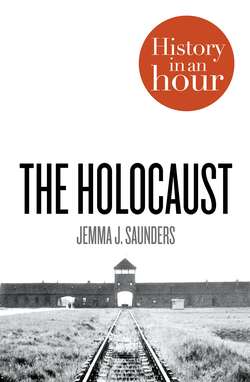Читать книгу The Holocaust: History in an Hour - Jemma Saunders J. - Страница 8
Hitler in Power: The Tide Turns
ОглавлениеAs the 1920s progressed, Germany slowly began to climb out of the economic depression that had engulfed the nation in the aftermath of the First World War, aided by short-term loans from America. The Wall Street stock market crash of October 1929, however, rendered Germany economically unstable once again, as America halted its financial assistance.
Hitler resumed his role in the NSDAP following his release from prison. The Nazis won just twelve seats in the Reichstag (German parliament) in 1928; however, by 1932 the political environment was significantly more volatile and they gained 230 seats after the summer elections, around 40 per cent of the vote. Six million Germans were unemployed by 1932 and the desperate situations in which they and many others found themselves led to increased support for the NSDAP, who promised major reforms that would return the nation to greatness and prosperity.
On 30 January 1933, Hitler became Chancellor of Germany. In August 1934 he named himself Führer, merging the roles of chancellor and president. The title adopted for the German empire and regime under Nazi governance was the Third Reich (the First and Second German Reichs had ended in 1806 and 1918 respectively). While the Nazis had played down their anti-Semitic policies during the election campaigns, within months of Hitler assuming power it became evident that Jews would not be treated favourably within this new system.
Under Hitler’s orders, a nation-wide boycott of Jewish shops and businesses took place on 1 April 1933. The Star of David, a symbol of Judaism, was daubed on windows and doors of Jewish-owned premises and Nazi Storm Troopers (the Sturm Abteilung, or SA) were positioned outside these businesses to discourage shoppers from entering.
Nazi Stormtroopers hold placards that state ‘Germans defend yourselves! Don’t buy from Jews!’ on 1 April 1933
Bundesarchiv, Bild 102-14469 / CC-BY-SA
Many German citizens ignored this boycott, but it was merely the beginning of the Nazi campaign against the Jews. Less than a week later, legislation was passed that forbade Jews from holding positions in the civil service. By the end of April many Jewish doctors and lawyers were also prohibited from working and Jewish children were facing segregation in schools.
It was not only Jews whom the Nazis turned against in 1933. People who were politically opposed to the regime began to be imprisoned in Dachau, the first concentration camp built in the Third Reich. Dachau was administered by the Schutzstaffel (SS), an elite police corps led by Heinrich Himmler. Among those subject to discrimination were Jehovah’s Witnesses, who refused to swear allegiance to Hitler, and homosexuals, who were considered subversive and a threat to a high birth rate.
Literature deemed un-German was destroyed in public book burnings, the biggest of which took place in Berlin on 10 May 1933. Tomes by Jewish authors were among those thrown in the flames, as were socialist, Communist and American works. A nineteenth-century German-Jewish poet, Heinrich Heine, wrote in the early 1820s, ‘where they burn books, they will also ultimately burn people’. Heine’s work was among that condemned to the bonfires and within the next decade, his cautionary prophecy would prove devastatingly accurate.
